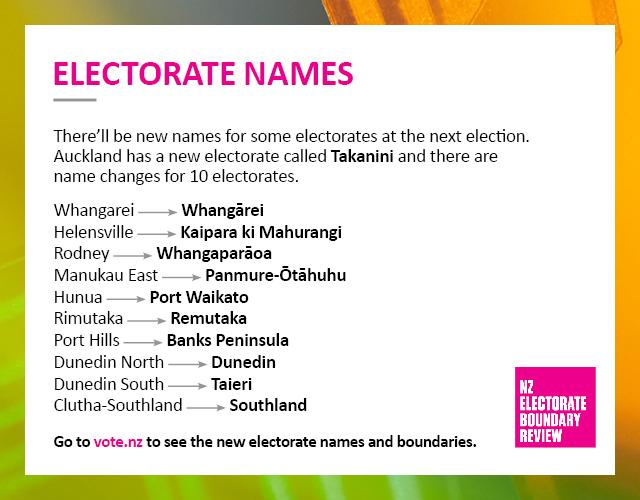Many New Zealanders will find themselves voting in a different electorate at this year's election as a result of the country's growing population.
A recent review found the population in each electorate has grown since 2014 and as some have grown at a greater rate than others, changes to boundaries have been needed. Regularly adjusting the electorate boundaries makes sure each electorate has about the same number of people.
Thirty-six electorates are unchanged, 30 general and five Māori electorates have been adjusted and one new electorate has been created in south Auckland.
Originally proposed as Flat Bush, the new electorate's name will be Takanini.
The Representation Commission, which has set the official electorate boundaries for the next two elections, has made changes mainly in Auckland, Waikato, Christchurch, Otago and Southland, with 7 percent of the population in a different electorate to 2017.
Most of the boundary changes were signalled in the proposed electorates report published in November 2019, when it was confirmed that there will be a new electorate resulting in one fewer list seats in Parliament than at the 2017 election.
When the Representation Commission proposed Flat Bush it received 22 objections, with some objecting to the name, suggesting alternatives such as Takanini, Flat Bush-Takanini, Manukau South, Manurewa East, Totara and Totara Park - but Takanini has won the crown.
The number of electorates will increase from 71 to 72, meaning in a 120-seat Parliament - excluding any overhang - there will be 72 electorate and 48 list seats.
Each electorate must not exceed 5 percent or be below 5 percent of the set quota, which is 64,899 for the North Island and 65,458 for the South Island.
There were 11 North Island electorates that have electoral populations that vary by more than plus or minus 5 percent of the 2018 quota, hence the need to shift them around a bit.

Electorate name changes for 2020 election
- Whangarei becomes Whangārei
- Helensville becomes Kaipara ki Mahurangi
- Rodney becomes Whangaparāoa
- Manukau East becomes Panmure-Ōtāhuhu
- Flat Bush becomes Takanini (new electorate)
- Hunua becomes Port Waikato
- Rimutaka becomes Remutaka
- Port Hills becomes Banks Peninsula
- Dunedin North becomes Dunedin
- Dunedin South becomes Taieri
- Clutha-Southland becomes Southland

Electorate changes for 2020 election
Click here to see the latest electorate map and full changes.
Changes made to the boundaries include:
The new Takanini electorate has been created by drawing from Manurewa, the former Hunua electorate, and Papakura, and includes Wattle Downs and Takanini.
The Hunua electorate has been renamed Port Waikato, and now includes population from Waikato.
The Rodney electorate has been redrawn to include Dairy Flat and Coatesville and renamed Whangaparāoa.
The Helensville electorate is renamed Kaipara ki Mahurangi, and has been extended into Northland, Whangaparāoa and Upper Harbour, and it loses the Waitakere Ranges to New Lynn.
The Manukau East electorate has been renamed Panmure-Ōtāhuhu, and a small area around Maungarei/Mount Wellington moves into it to maintain links with Panmure following requests from the public.
There are no boundary changes for 31 electorates in the North Island, including Auckland Central, Botany, East Coast Bays, Epsom, Kelston, Māngere, Mt Albert, North Shore, Northcote, Pakuranga, Tāmaki and Te Atatū.
In the South Island, Brightwater - a town in the Nelson electorate - has been moved into West Coast-Tasman.
The Selwyn electorate has the fastest-growing population, so has lost the Banks Peninsula area to the newly named Banks Peninsula electorate, formerly known as Port Hills.
The Waitaki electorate has lost the Alexandra and Clyde area to the Clutha-Southland electorate, now just called Southland.
The Otago Peninsula has been moved from the Dunedin South electorate to Dunedin North, while south Otago has been added to Dunedin South from Clutha-Southland.
As a result of that big shakeup, Dunedin South becomes Taieri and Dunedin North becomes Dunedin.
Invercargill electorate has been expanded into western Southland, including Tuatapere, so that Winton and The Catlins can be added to Invercargill as the public requested.
There have been no changes made to Christchurch Central, Kaikōura and Waimakariri.
As for the Māori electorates, the number remains seven, but some boundary changes have been made.
Tāmaki Makaurau has gained an area around Te Atatū South from Te Tai Tokerau, and an area to the east of Manurewa and Waiheke Island from Hauraki-Waikato.
No boundary changes have been made to Te Tai Hauāuru and Waiariki.



